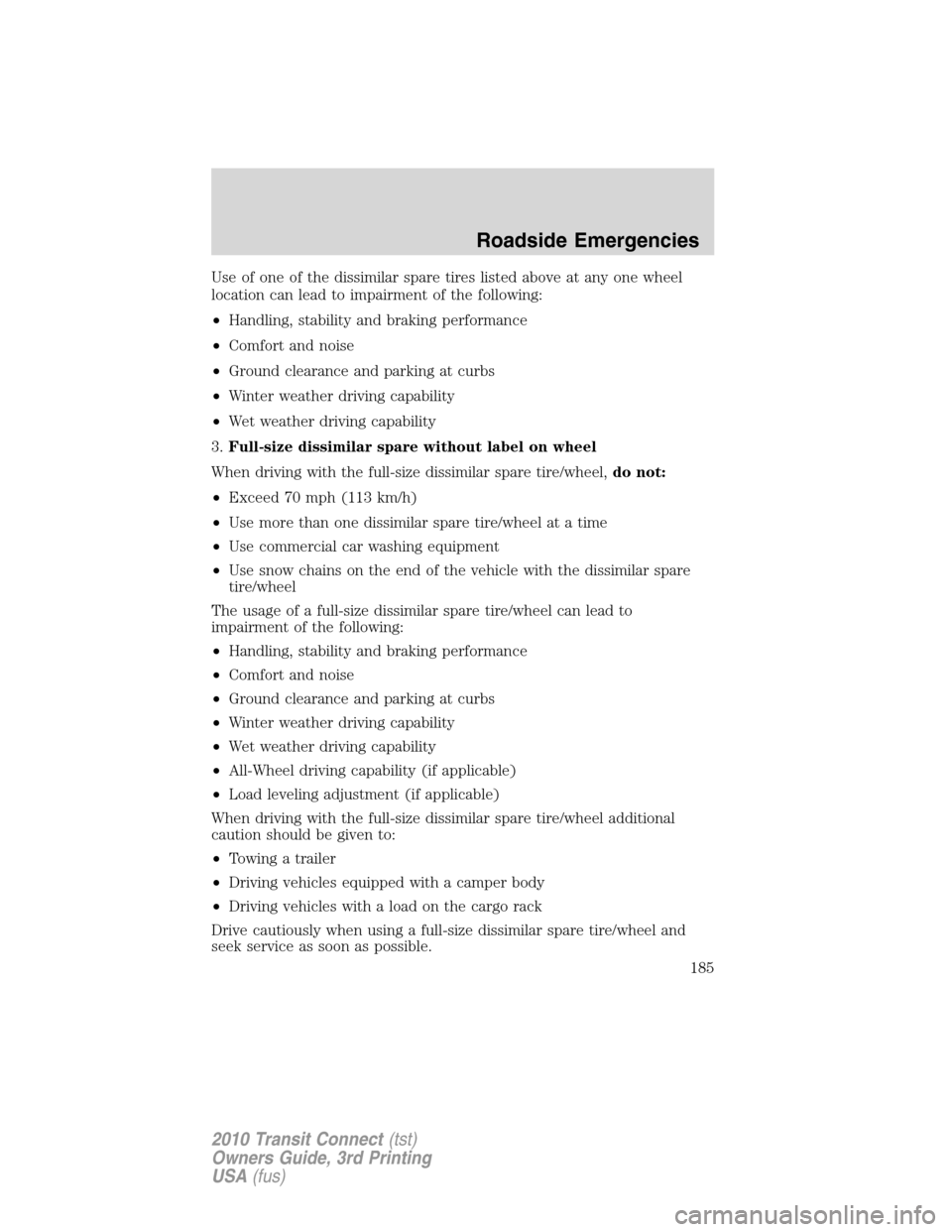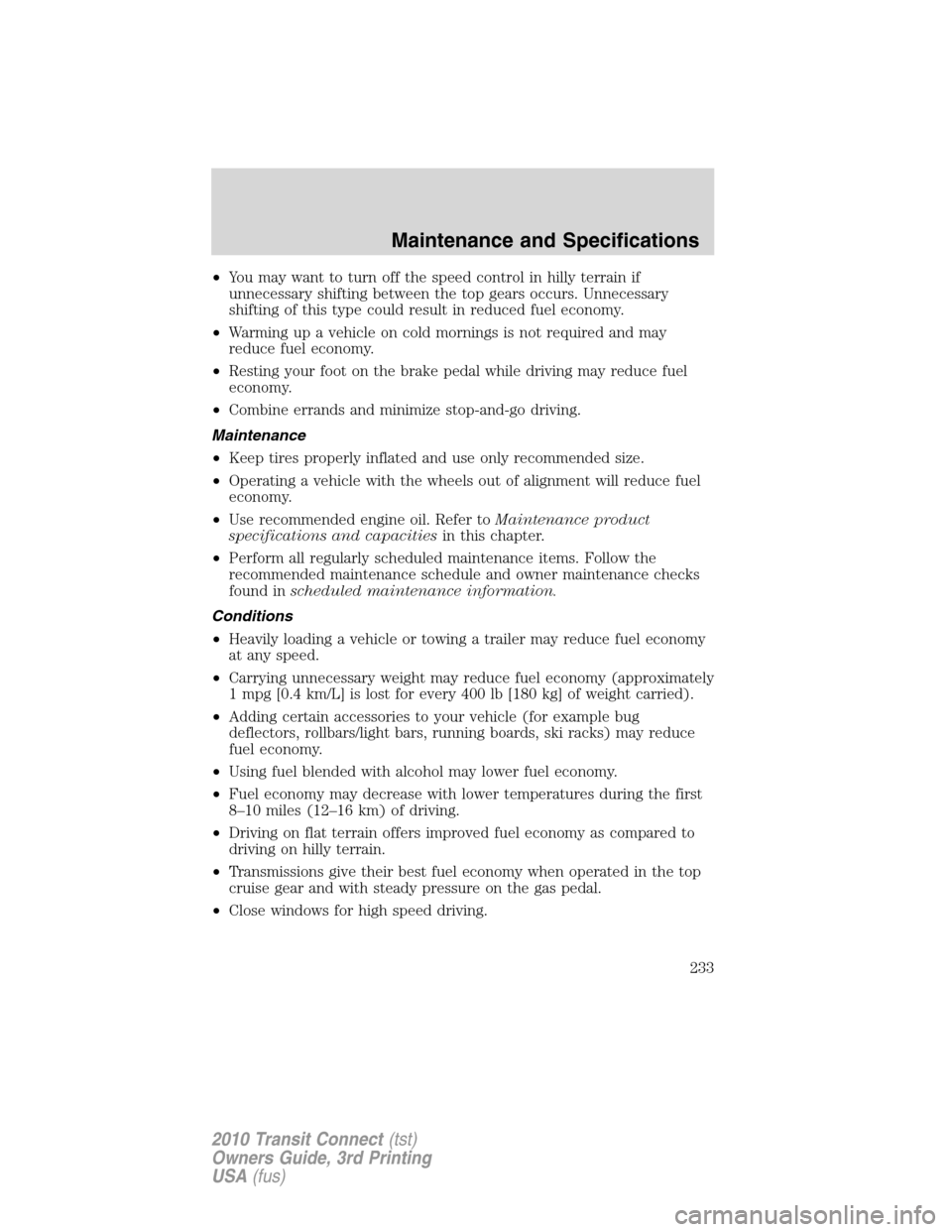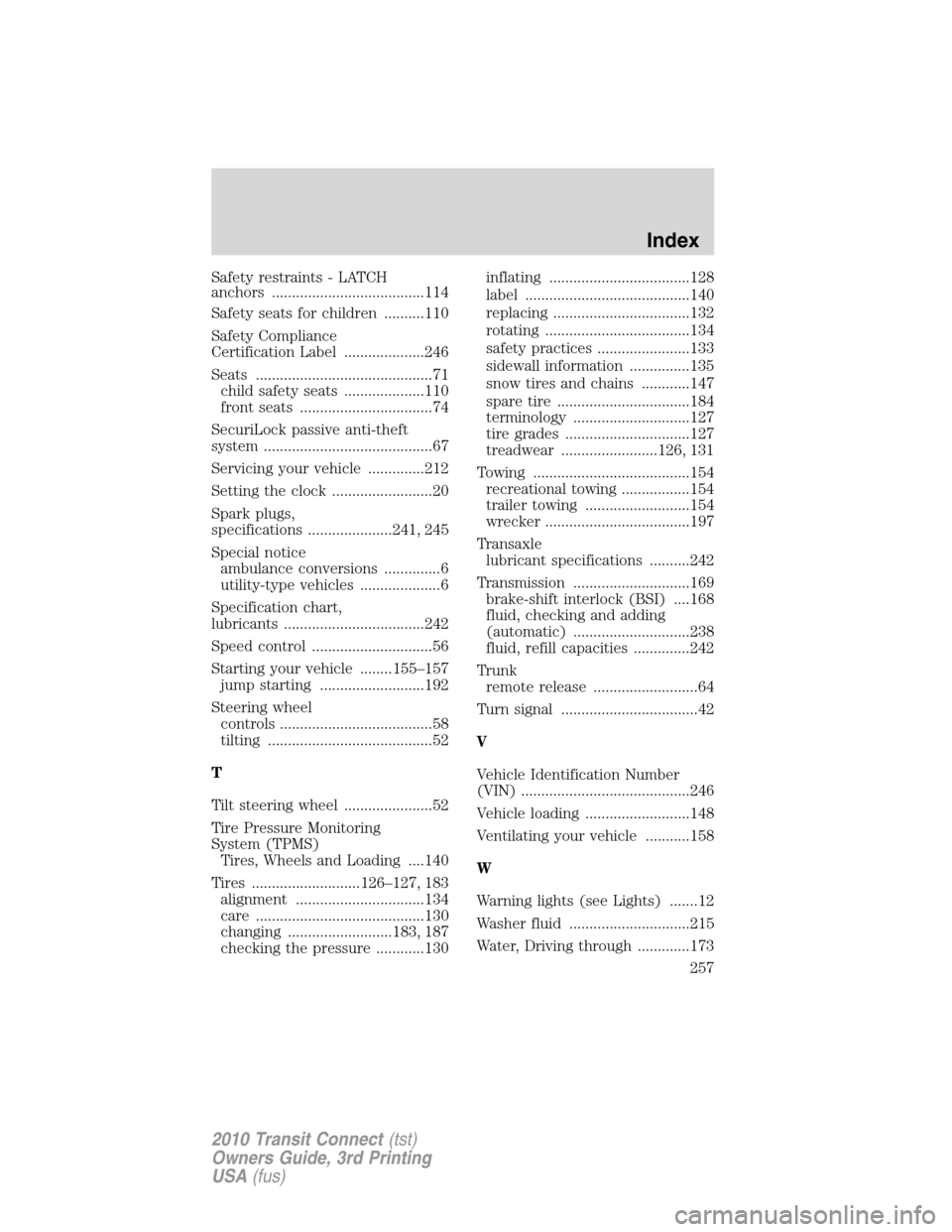tires FORD TRANSIT CONNECT 2010 1.G Service Manual
[x] Cancel search | Manufacturer: FORD, Model Year: 2010, Model line: TRANSIT CONNECT, Model: FORD TRANSIT CONNECT 2010 1.GPages: 258, PDF Size: 1.98 MB
Page 185 of 258

Use of one of the dissimilar spare tires listed above at any one wheel
location can lead to impairment of the following:
•Handling, stability and braking performance
•Comfort and noise
•Ground clearance and parking at curbs
•Winter weather driving capability
•Wet weather driving capability
3.Full-size dissimilar spare without label on wheel
When driving with the full-size dissimilar spare tire/wheel,do not:
•Exceed 70 mph (113 km/h)
•Use more than one dissimilar spare tire/wheel at a time
•Use commercial car washing equipment
•Use snow chains on the end of the vehicle with the dissimilar spare
tire/wheel
The usage of a full-size dissimilar spare tire/wheel can lead to
impairment of the following:
•Handling, stability and braking performance
•Comfort and noise
•Ground clearance and parking at curbs
•Winter weather driving capability
•Wet weather driving capability
•All-Wheel driving capability (if applicable)
•Load leveling adjustment (if applicable)
When driving with the full-size dissimilar spare tire/wheel additional
caution should be given to:
•Towing a trailer
•Driving vehicles equipped with a camper body
•Driving vehicles with a load on the cargo rack
Drive cautiously when using a full-size dissimilar spare tire/wheel and
seek service as soon as possible.
Roadside Emergencies
185
2010 Transit Connect(tst)
Owners Guide, 3rd Printing
USA(fus)
Page 233 of 258

•You may want to turn off the speed control in hilly terrain if
unnecessary shifting between the top gears occurs. Unnecessary
shifting of this type could result in reduced fuel economy.
•Warming up a vehicle on cold mornings is not required and may
reduce fuel economy.
•Resting your foot on the brake pedal while driving may reduce fuel
economy.
•Combine errands and minimize stop-and-go driving.
Maintenance
•Keep tires properly inflated and use only recommended size.
•Operating a vehicle with the wheels out of alignment will reduce fuel
economy.
•Use recommended engine oil. Refer toMaintenance product
specifications and capacitiesin this chapter.
•Perform all regularly scheduled maintenance items. Follow the
recommended maintenance schedule and owner maintenance checks
found inscheduled maintenance information.
Conditions
•Heavily loading a vehicle or towing a trailer may reduce fuel economy
at any speed.
•Carrying unnecessary weight may reduce fuel economy (approximately
1 mpg [0.4 km/L] is lost for every 400 lb [180 kg] of weight carried).
•Adding certain accessories to your vehicle (for example bug
deflectors, rollbars/light bars, running boards, ski racks) may reduce
fuel economy.
•Using fuel blended with alcohol may lower fuel economy.
•Fuel economy may decrease with lower temperatures during the first
8–10 miles (12–16 km) of driving.
•Driving on flat terrain offers improved fuel economy as compared to
driving on hilly terrain.
•Transmissions give their best fuel economy when operated in the top
cruise gear and with steady pressure on the gas pedal.
•Close windows for high speed driving.
Maintenance and Specifications
233
2010 Transit Connect(tst)
Owners Guide, 3rd Printing
USA(fus)
Page 257 of 258

Safety restraints - LATCH
anchors ......................................114
Safety seats for children ..........110
Safety Compliance
Certification Label ....................246
Seats ............................................71
child safety seats ....................110
front seats .................................74
SecuriLock passive anti-theft
system ..........................................67
Servicing your vehicle ..............212
Setting the clock .........................20
Spark plugs,
specifications .....................241, 245
Special notice
ambulance conversions ..............6
utility-type vehicles ....................6
Specification chart,
lubricants ...................................242
Speed control ..............................56
Starting your vehicle ........155–157
jump starting ..........................192
Steering wheel
controls ......................................58
tilting .........................................52
T
Tilt steering wheel ......................52
Tire Pressure Monitoring
System (TPMS)
Tires, Wheels and Loading ....140
Tires ...........................126–127, 183
alignment ................................134
care ..........................................130
changing ..........................183, 187
checking the pressure ............130inflating ...................................128
label .........................................140
replacing ..................................132
rotating ....................................134
safety practices .......................133
sidewall information ...............135
snow tires and chains ............147
spare tire .................................184
terminology .............................127
tire grades ...............................127
treadwear ........................126, 131
Towing .......................................154
recreational towing .................154
trailer towing ..........................154
wrecker ....................................197
Transaxle
lubricant specifications ..........242
Transmission .............................169
brake-shift interlock (BSI) ....168
fluid, checking and adding
(automatic) .............................238
fluid, refill capacities ..............242
Trunk
remote release ..........................64
Turn signal ..................................42
V
Vehicle Identification Number
(VIN) ..........................................246
Vehicle loading ..........................148
Ventilating your vehicle ...........158
W
Warning lights (see Lights) .......12
Washer fluid ..............................215
Water, Driving through .............173
Index
257
2010 Transit Connect(tst)
Owners Guide, 3rd Printing
USA(fus)